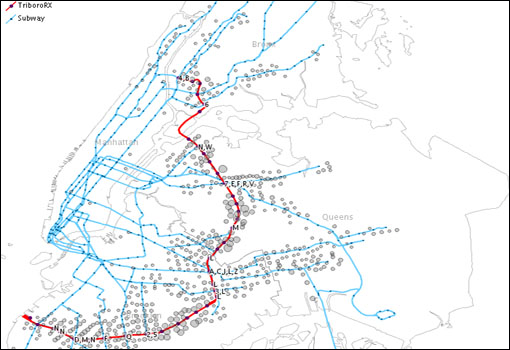For the Regional Plan Association, Michael Frumin visualized their plan for a rapid transit line in Brooklyn, Queens, and the Bronx that could be built almost entirely on pre-existing rail and would connect with at least twenty existing subway lines. The "Triboro RX", which originated in the 1996 Third Regional Plan, could provide effective transit between these boroughs at a fraction of the cost of most transit projects.
Working with Jeff Zupan and Alexis Perrotta, I helped to develop a possible alignment for the Triboro RX, and a crude estimate of what levels of initial commuter ridership one could expect to see if it were built. At the end of the day, we can comfortably say that at least 76,000 New Yorkers (including 32,000 diverting from other modes of transportation) would use the Triboro RX to get to and from their jobs every day. This number that is quite competitive with many existing lines, and without ever touching the island of Manhattan.
At the heart of our ability to make this estimate is the Journey-to-Work data published by the census -- counts of commuters between every census tract and every other census tract in the city. Given these flow data, the shape of the subway network with and without the Triboro RX, and a rough model of how people make travel decisions on public transportation, it's not so hard to guess which subway riders would use a new transit line if it were built. Estimating new transit riders is more nuanced, but we did our best with limited resources.
To create these transportation models, Frumin used one of The Open Planning Project's software projects GeoServer. Take a look at the fruits of Michael's labor:
How would the TRX tie into congestion pricing? The graphic above shows that the TRX would do a great job of providing mass transit to unserved communities in the outer boroughs.






